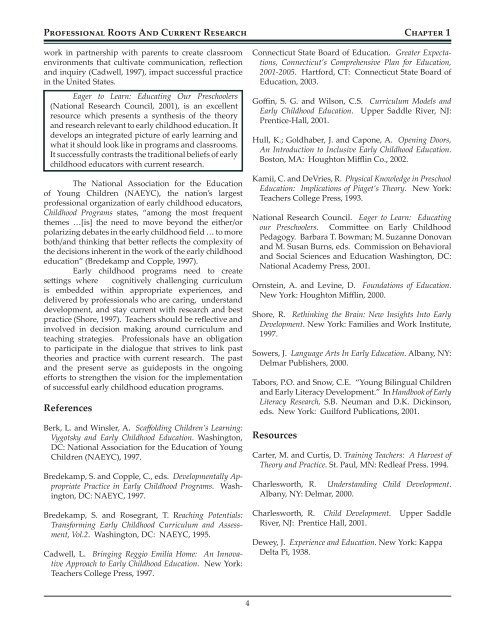Early Childhood - Connecticut State Department of Education
Early Childhood - Connecticut State Department of Education
Early Childhood - Connecticut State Department of Education
You also want an ePaper? Increase the reach of your titles
YUMPU automatically turns print PDFs into web optimized ePapers that Google loves.
Pr<strong>of</strong>essional Roots And Current Research Chapter 1<br />
work in partnership with parents to create classroom<br />
environments that cultivate communication, reflection<br />
and inquiry (Cadwell, 997), impact successful practice<br />
in the United <strong>State</strong>s.<br />
Eager to Learn: Educating Our Preschoolers<br />
(National Research Council, 00 ), is an excellent<br />
resource which presents a synthesis <strong>of</strong> the theory<br />
and research relevant to early childhood education. It<br />
develops an integrated picture <strong>of</strong> early learning and<br />
what it should look like in programs and classrooms.<br />
It successfully contrasts the traditional beliefs <strong>of</strong> early<br />
childhood educators with current research.<br />
The National Association for the <strong>Education</strong><br />
<strong>of</strong> Young Children (NAEYC), the nation’s largest<br />
pr<strong>of</strong>essional organization <strong>of</strong> early childhood educators,<br />
<strong>Childhood</strong> Programs states, “among the most frequent<br />
themes …[is] the need to move beyond the either/or<br />
polarizing debates in the early childhood field … to more<br />
both/and thinking that better reflects the complexity <strong>of</strong><br />
the decisions inherent in the work <strong>of</strong> the early childhood<br />
education” (Bredekamp and Copple, 997).<br />
<strong>Early</strong> childhood programs need to create<br />
settings where cognitively challenging curriculum<br />
is embedded within appropriate experiences, and<br />
delivered by pr<strong>of</strong>essionals who are caring, understand<br />
development, and stay current with research and best<br />
practice (Shore, 1997). Teachers should be reflective and<br />
involved in decision making around curriculum and<br />
teaching strategies. Pr<strong>of</strong>essionals have an obligation<br />
to participate in the dialogue that strives to link past<br />
theories and practice with current research. The past<br />
and the present serve as guideposts in the ongoing<br />
efforts to strengthen the vision for the implementation<br />
<strong>of</strong> successful early childhood education programs.<br />
References<br />
Berk, L. and Winsler, A. Scaffolding Children’s Learning:<br />
Vygotsky and <strong>Early</strong> <strong>Childhood</strong> <strong>Education</strong>. Washington,<br />
DC: National Association for the <strong>Education</strong> <strong>of</strong> Young<br />
Children (NAEYC), 997.<br />
Bredekamp, S. and Copple, C., eds. Developmentally Appropriate<br />
Practice in <strong>Early</strong> <strong>Childhood</strong> Programs. Washington,<br />
DC: NAEYC, 1997.<br />
Bredekamp, S. and Rosegrant, T. Reaching Potentials:<br />
Transforming <strong>Early</strong> <strong>Childhood</strong> Curriculum and Assessment,<br />
Vol.2. Washington, DC: NAEYC, 1995.<br />
Cadwell, L. Bringing Reggio Emilia Home: An Innovative<br />
Approach to <strong>Early</strong> <strong>Childhood</strong> <strong>Education</strong>. New York:<br />
Teachers College Press, 997.<br />
4<br />
<strong>Connecticut</strong> <strong>State</strong> Board <strong>of</strong> <strong>Education</strong>. Greater Expectations,<br />
<strong>Connecticut</strong>’s Comprehensive Plan for <strong>Education</strong>,<br />
2001-2005. Hartford, CT: <strong>Connecticut</strong> <strong>State</strong> Board <strong>of</strong><br />
<strong>Education</strong>, 003.<br />
G<strong>of</strong>fin, S. G. and Wilson, C.S. Curriculum Models and<br />
<strong>Early</strong> <strong>Childhood</strong> <strong>Education</strong>. Upper Saddle River, NJ:<br />
Prentice-Hall, 00 .<br />
Hull, K.; Goldhaber, J. and Capone, A. Opening Doors,<br />
An Introduction to Inclusive <strong>Early</strong> <strong>Childhood</strong> <strong>Education</strong>.<br />
Boston, MA: Houghton Mifflin Co., 2002.<br />
Kamii, C. and DeVries, R. Physical Knowledge in Preschool<br />
<strong>Education</strong>: Implications <strong>of</strong> Piaget’s Theory. New York:<br />
Teachers College Press, 993.<br />
National Research Council. Eager to Learn: Educating<br />
our Preschoolers. Committee on <strong>Early</strong> <strong>Childhood</strong><br />
Pedagogy. Barbara T. Bowman; M. Suzanne Donovan<br />
and M. Susan Burns, eds. Commission on Behavioral<br />
and Social Sciences and <strong>Education</strong> Washington, DC:<br />
National Academy Press, 00 .<br />
Ornstein, A. and Levine, D. Foundations <strong>of</strong> <strong>Education</strong>.<br />
New York: Houghton Mifflin, 2000.<br />
Shore, R. Rethinking the Brain: New Insights Into <strong>Early</strong><br />
Development. New York: Families and Work Institute,<br />
997.<br />
Sowers, J. Language Arts In <strong>Early</strong> <strong>Education</strong>. Albany, NY:<br />
Delmar Publishers, 000.<br />
Tabors, P.O. and Snow, C.E. “Young Bilingual Children<br />
and <strong>Early</strong> Literacy Development.” In Handbook <strong>of</strong> <strong>Early</strong><br />
Literacy Research, S.B. Neuman and D.K. Dickinson,<br />
eds. New York: Guilford Publications, 2001.<br />
Resources<br />
Carter, M. and Curtis, D. Training Teachers: A Harvest <strong>of</strong><br />
Theory and Practice. St. Paul, MN: Redleaf Press. 1994.<br />
Charlesworth, R. Understanding Child Development.<br />
Albany, NY: Delmar, 2000.<br />
Charlesworth, R. Child Development. Upper Saddle<br />
River, NJ: Prentice Hall, 2001.<br />
Dewey, J. Experience and <strong>Education</strong>. New York: Kappa<br />
Delta Pi, 938.

















